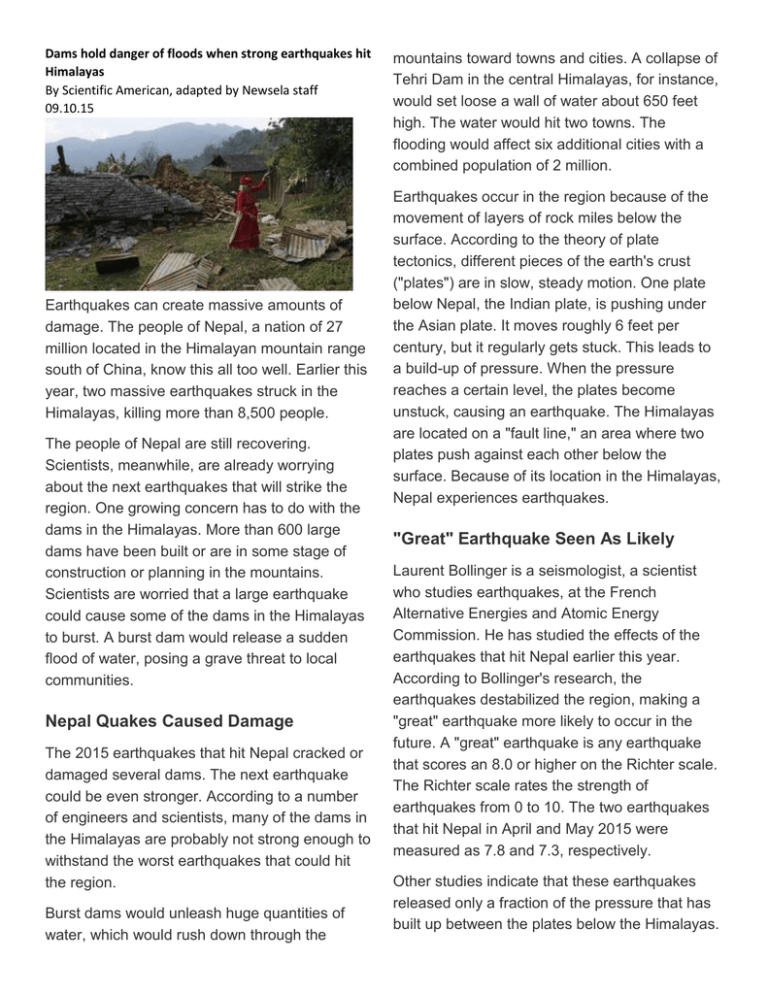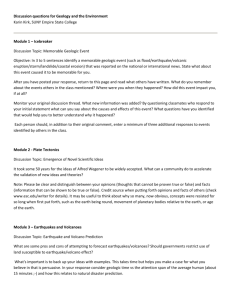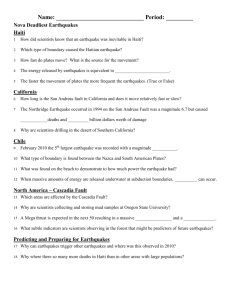Region Article
advertisement

Dams hold danger of floods when strong earthquakes hit Himalayas By Scientific American, adapted by Newsela staff 09.10.15 Earthquakes can create massive amounts of damage. The people of Nepal, a nation of 27 million located in the Himalayan mountain range south of China, know this all too well. Earlier this year, two massive earthquakes struck in the Himalayas, killing more than 8,500 people. The people of Nepal are still recovering. Scientists, meanwhile, are already worrying about the next earthquakes that will strike the region. One growing concern has to do with the dams in the Himalayas. More than 600 large dams have been built or are in some stage of construction or planning in the mountains. Scientists are worried that a large earthquake could cause some of the dams in the Himalayas to burst. A burst dam would release a sudden flood of water, posing a grave threat to local communities. Nepal Quakes Caused Damage The 2015 earthquakes that hit Nepal cracked or damaged several dams. The next earthquake could be even stronger. According to a number of engineers and scientists, many of the dams in the Himalayas are probably not strong enough to withstand the worst earthquakes that could hit the region. Burst dams would unleash huge quantities of water, which would rush down through the mountains toward towns and cities. A collapse of Tehri Dam in the central Himalayas, for instance, would set loose a wall of water about 650 feet high. The water would hit two towns. The flooding would affect six additional cities with a combined population of 2 million. Earthquakes occur in the region because of the movement of layers of rock miles below the surface. According to the theory of plate tectonics, different pieces of the earth's crust ("plates") are in slow, steady motion. One plate below Nepal, the Indian plate, is pushing under the Asian plate. It moves roughly 6 feet per century, but it regularly gets stuck. This leads to a build-up of pressure. When the pressure reaches a certain level, the plates become unstuck, causing an earthquake. The Himalayas are located on a "fault line," an area where two plates push against each other below the surface. Because of its location in the Himalayas, Nepal experiences earthquakes. "Great" Earthquake Seen As Likely Laurent Bollinger is a seismologist, a scientist who studies earthquakes, at the French Alternative Energies and Atomic Energy Commission. He has studied the effects of the earthquakes that hit Nepal earlier this year. According to Bollinger's research, the earthquakes destabilized the region, making a "great" earthquake more likely to occur in the future. A "great" earthquake is any earthquake that scores an 8.0 or higher on the Richter scale. The Richter scale rates the strength of earthquakes from 0 to 10. The two earthquakes that hit Nepal in April and May 2015 were measured as 7.8 and 7.3, respectively. Other studies indicate that these earthquakes released only a fraction of the pressure that has built up between the plates below the Himalayas. This suggests that more earthquakes are likely in the coming years. Vinod K. Gaur is a seismologist at the CSIR Fourth Paradigm Institute in India. He says that there could be a 8.0 earthquake in the Himalayas in the near future. If there are no earthquakes for 200 years, the pressure will keep increasing. When an earthquake finally comes, it will be even more powerful. Given the likelihood of more earthquakes in Nepal, the dams in the region have to be specially reinforced. They must be able to withstand the strong ground shaking of an extreme earthquake, says Martin Wieland of the International Commission on Large Dams. India, China Secretive About Dam Designs Part of the trouble is that scientists are not always allowed to study the dams freely to determine whether or not they are strong enough. Most of the dams in the region supply power to India and China. Although every nation has its own regulations, India and China are secretive about their dam designs. Outsiders are rarely allowed to examine Indian and Chinese dams. Scientists who have been able to study dams in the region have sometimes found cause for concern. Probe International is a Canadian environmental research organization. It studied China's Three Gorges Dam. It found that the designers had not considered worst-case scenarios when designing the dam's earthquake resistance. Scientists Seek Safer Construction If the Indian and Chinese governments have not put in place the proper reinforcements, hundreds of dams could be in danger of bursting when the next big earthquake hits the Himalayas. If that happens during a rainy season, when the dams are full, the burst dams could create massive damage. A handful of scientists have taken the lead in arguing for safer dam construction. They have only had limited success, though. For now, all they can do is call attention to the problem. Scientists hope that, with the help of public pressure, dams in the Himalayas will be reinforced to withstand great earthquakes. Otherwise, the next great earthquake in the area may result in a man-made tsunami.








